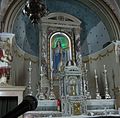
Nahf is an Arab town in the Northern District of Israel. It is located in between the lower and upper Galilee, about 23 kilometres (14 mi) east of Acre. In 2022 it had a population of 13,717. Archaeologists believe that the area was an important center for viticulture in the Hellenistic period and possibly the Early Bronze Age IB period.
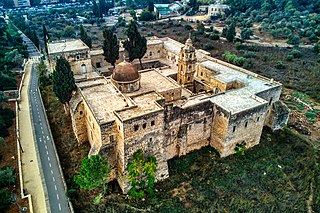
The Monastery of the Cross is an Eastern Orthodox monastery near the Nayot neighborhood of Jerusalem. It is located in the Valley of the Cross, below the Israel Museum and the Knesset.

Ein Karem is a historic mountain village southwest of Jerusalem, presently a neighborhood in the outskirts of the modern city, within the Jerusalem District. It is the site of the Hadassah Medical Center.
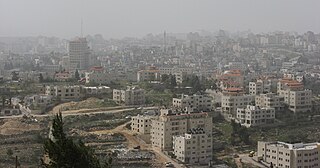
Al-Bireh, al-Birah, or el-Bira is a Palestinian city in the central West Bank, 15 kilometers (9.3 mi) north of Jerusalem. It is the capital of the Ramallah and al-Bireh Governorate of the State of Palestine. It is situated on the central ridge running through the West Bank and is 860 meters (2,820 ft) above sea level, covering an area of 22.4 square kilometers (8.6 sq mi). Al-Bireh is under the administration of the Palestinian National Authority.
Kafr Kanna is an Arab town in the Galilee, part of the Northern District of Israel. It is associated by Christians with the New Testament village of Cana, where Jesus turned water into wine. In 2022 its population was 24,108. It has a religiously mixed population of Muslims and Christians from different denominations.

Suba was a Palestinian Arab village west of Jerusalem that was depopulated and destroyed in 1948. The site of the village lies on the summit of a conical hill called Tel Tzova, or Jabal Suba, rising 769 meters above sea level, and it was built on the ruins of a Crusader castle.

Aboud is a Palestinian village in the Ramallah and al-Bireh Governorate of the State of Palestine, in the central West Bank, northwest of Ramallah and 30 kilometers north of Jerusalem. Nearby towns include al-Lubban to the northeast and Bani Zeid to the northwest.

The Church of the Visitation is a Catholic church in Ein Karem, Jerusalem, and honors the Visitation made by the Virgin Mary, the mother of Jesus, to Elizabeth, the mother of John the Baptist. This is the site where tradition says that Mary recited her song of praise, the Magnificat, one of the most ancient Marian hymns.
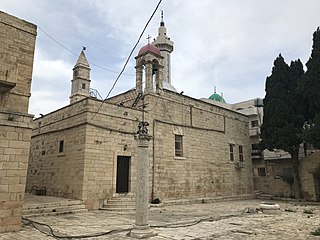
The Monastery and Church of Saint George in Al-Khader is an Eastern Orthodox Christian religious site in the Palestinian town of al-Khader, near Beit Jala and Bethlehem, in the central West Bank of the State of Palestine. The town of Al-Khader is named after Saint George, who in Arab culture is known as "al-Khadr"; the church is considered to be the most important sanctuary to al-Khadr in Palestine.
Beit Einun or Bayt 'Anun is a Palestinian village in the Hebron Governorate, located five kilometers northeast of Hebron in the southern West Bank. According to the Palestinian Central Bureau of Statistics, the village had a population of 1,928 inhabitants in 2017.

Merhavia is a kibbutz in northern Israel. Located to the east of Afula, it falls under the jurisdiction of Jezreel Valley Regional Council. In 2022 it had a population of 1,331.

al-Karmil is a Palestinian village located twelve kilometers south of Hebron. The village is in the Hebron Governorate Southern West Bank, within Area A under total Palestinian control. According to the Palestinian Central Bureau of Statistics, the village had a population of 9,740 in 2017. The primary health care facilities for the village are designated by the Ministry of Health as level 2.

The Monastery of Saint John in the Wilderness is a Franciscan Catholic monastery built next to a spring on a wooded slope just north of Even Sapir, Israel, and across the valley from Sataf. It is located a short distance from Ein Karem, the traditional birthplace of Saint John the Baptist, and south of Jerusalem. It is also known as Saint John in the Desert or the Desert of Saint John. The convent is the property of the Franciscan Custody of the Holy Land.

Salbit was a Palestinian Arab village located 12 kilometers (7.5 mi) southeast of al-Ramla. Salbit was depopulated during the 1948 Arab–Israeli War after a military assault by Israeli forces. The Israeli locality of Shaalvim was established on the former village's lands in 1951.
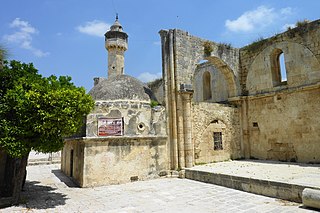
The Nabi Yahya Mosque, literally the Mosque of the Prophet John, is a mosque containing the traditional tomb of John the Baptist, in Sebastia, Palestine. The mosque also contains the tombs of Elisha and Obadiah, prophets who were buried next to John the Baptist. This mosque was originally a church.

The Church of Saint Anne is a French Roman Catholic church and part of the French national domain in the Holy Land located in the Muslim Quarter of the Old City of Jerusalem, near the start of the Via Dolorosa, next to the Lions' Gate. The site is also known as al-Madrasa as-Salahiyya.

The Chapel of the Milk Grotto of Our Lady, also called Grotto of Our Lady or Milk Grotto, is a Catholic chapel in Bethlehem, in the West Bank, erected in 1872. Since Byzantine times, the place has been a center of Christian pilgrimage, maintained since its last erection together with its Marian shrine and monastery by the Custody of the Holy Land of the Order of the Friars Minor of the Catholic Church in Palestine. The Status Quo, a 250-year-old understanding between religious communities, applies to the site.

Khirbet Beit Zakariyyah is a small Palestinian village southwest of Bethlehem in the West Bank, perched on a hill that rises about 995 metres (3,264 ft) above sea level. Administratively, it is associated with the village of Artas under the Bethlehem Governorate. It is also located in between the Israeli settlements of Alon Shevut and Rosh Tzurim, both of which were built on land confiscated from the village. The village had a population of 142 in 2017.

The Inn of the Good Samaritan is a national park, museum, ancient archaeological site and former inn administered by the Israel Nature and Parks Authority located near Ma'ale Adumim, halfway between Jerusalem and Jericho, at an elevation of 298 meters above sea level.

The Monastery Saint Claire, also known as the Convent of Mary's Fear and by other names, is a convent of the Poor Clares on Tremor Hill in southern Nazareth, Israel. Established in 1884, it is primarily known for the productive time the now-sainted Charles de Foucauld spent there at the end of the 19th century. Expelled from the Ottoman Empire at the onset of World War I, the nuns of the abbey relocated to Malta, founding a new community there. The Sisters of St Clare returned to Nazareth in 1949 but used newer facilities on 3105 Street on the north slope of Tremor Hill. Their former location beside what is now Paulus HaShishi Street was repaired by the Servants of Charity for use as a special needs school in the 1970s.



